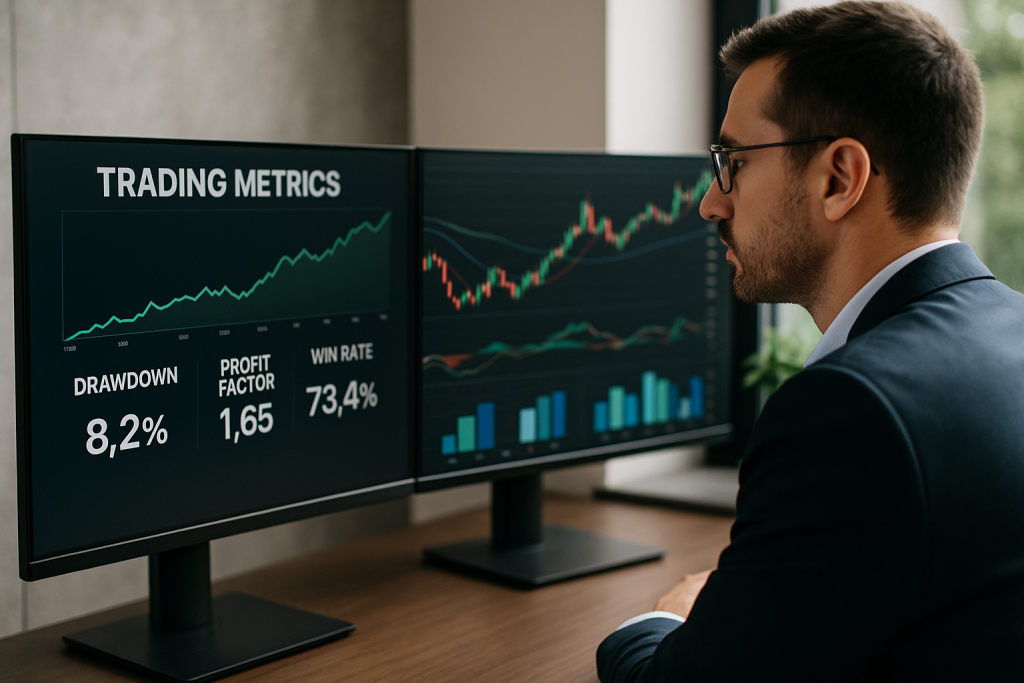
Using automated trading robots (EAs) is a powerful tool, but that doesn’t mean you can completely forget about them. Like any system, they require monitoring, and one of the best practices for maintaining their performance and stability is to conduct a monthly audit. This systematic review allows you to detect changes in the robot’s behavior, identify opportunities for improvement, and make informed decisions, such as adjusting parameters, scaling strategies that are performing well, or stopping those that begin to show signs of deterioration.
Current vs. Historical Drawdown
One of the most important indicators to review each month is the drawdown. It’s not enough to know how much a robot has earned; it’s also essential to understand how much of your capital has been at risk. Drawdown tells you exactly that: what the largest drop was from the high point of your account to a subsequent low. In your monthly audit, it’s a good idea to compare the recent drawdown with what you saw in the backtest or forward test. If you notice that the current drawdown clearly exceeds those historical values, it’s a warning sign that deserves attention. It may be a natural consequence of market conditions, but it could also indicate that the strategy is losing effectiveness or needs adjustments.
Profit Factor and its evolution
Another metric that gives you a clear view of the robot’s actual performance is the Profit Factor. This ratio compares total wins to total losses and serves as a way to measure the strategy’s overall efficiency. If the Profit Factor stays above 1.5, we’re generally talking about a healthy robot. If it’s between 1.2 and 1.5, it may still be useful, but it’s worth monitoring its evolution. A progressive decline month after month could indicate that market conditions are changing or that the strategy is suffering from wear and tear. And if it falls below 1.2, you should consider whether it’s still viable to keep that strategy active.
Actual vs. expected win rate
A monthly audit also allows you to check if the percentage of winning trades your EA is producing is in line with expectations. For example, if in backtesting the robot had a win rate of 65% but during the last month it has only hit 42% of the trades, this difference should not be overlooked. Sometimes these deviations are the result of natural market variability. However, if this behavior is repeated over several months, it may indicate that something is not working as it should. This analysis is especially useful in distinguishing between a normal bad streak and a strategy that needs further adjustment.

Correlation between strategies
If you’re using multiple robots at the same time, another important aspect to include in your audit is the correlation between them. Often, you can unwittingly end up using EAs that operate in very similar ways, or that depend on the same type of market movement. This can generate spectacular results when conditions are favorable, but it can also exacerbate losses when things go wrong. Observing how strategies behave together, and whether they’re winning or losing at the same time, helps you build a more diversified and resilient portfolio.
Activity and consistency
Finally, it’s helpful to look at how many trades each robot has made during the month. If an EA that used to trade frequently starts drastically decreasing its number of entries, it may not be finding opportunities under the current conditions, or it could even be experiencing a technical glitch. It’s also worth checking for a loss of consistency in the way it trades: changes in trade sizes, different times of day, or deviations from the behavior you expected. All of these elements help identify early signs that something might be changing.
Decision-making: Continue, adjust, pause, or escalate?
Once you’ve reviewed all these metrics, the most important part of the audit comes: making decisions. If the performance is within expected margins, you can continue trading with confidence. If there are slight deviations but the robot remains profitable, you could adjust certain parameters to optimize its performance. If you notice a clear and consistent decline, it may be best to temporarily pause that strategy and analyze it in more detail. On the other hand, if a robot has demonstrated solidity, stability, and consistent results for several months, it’s a good candidate for scaling and increasing your exposure.


